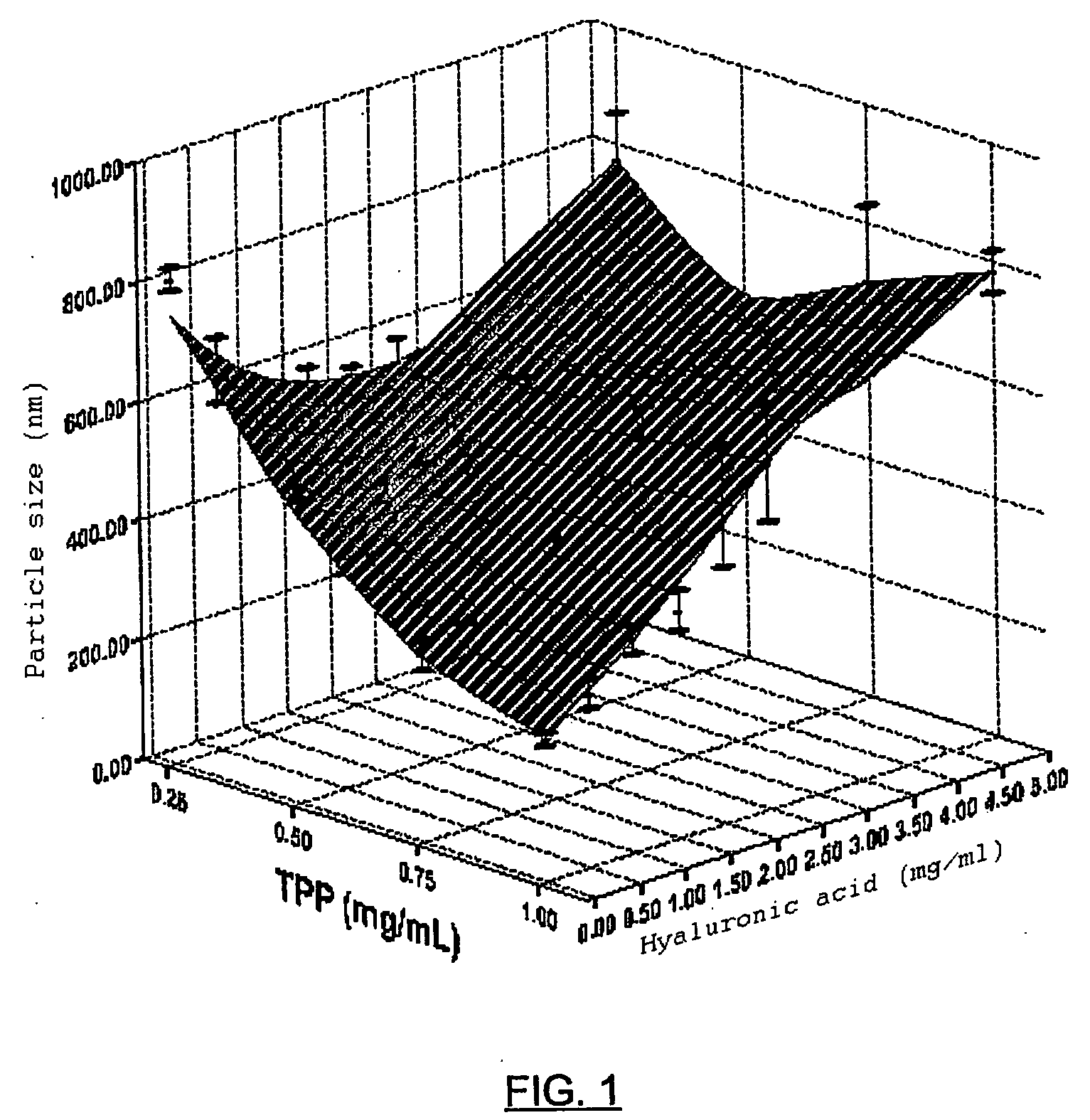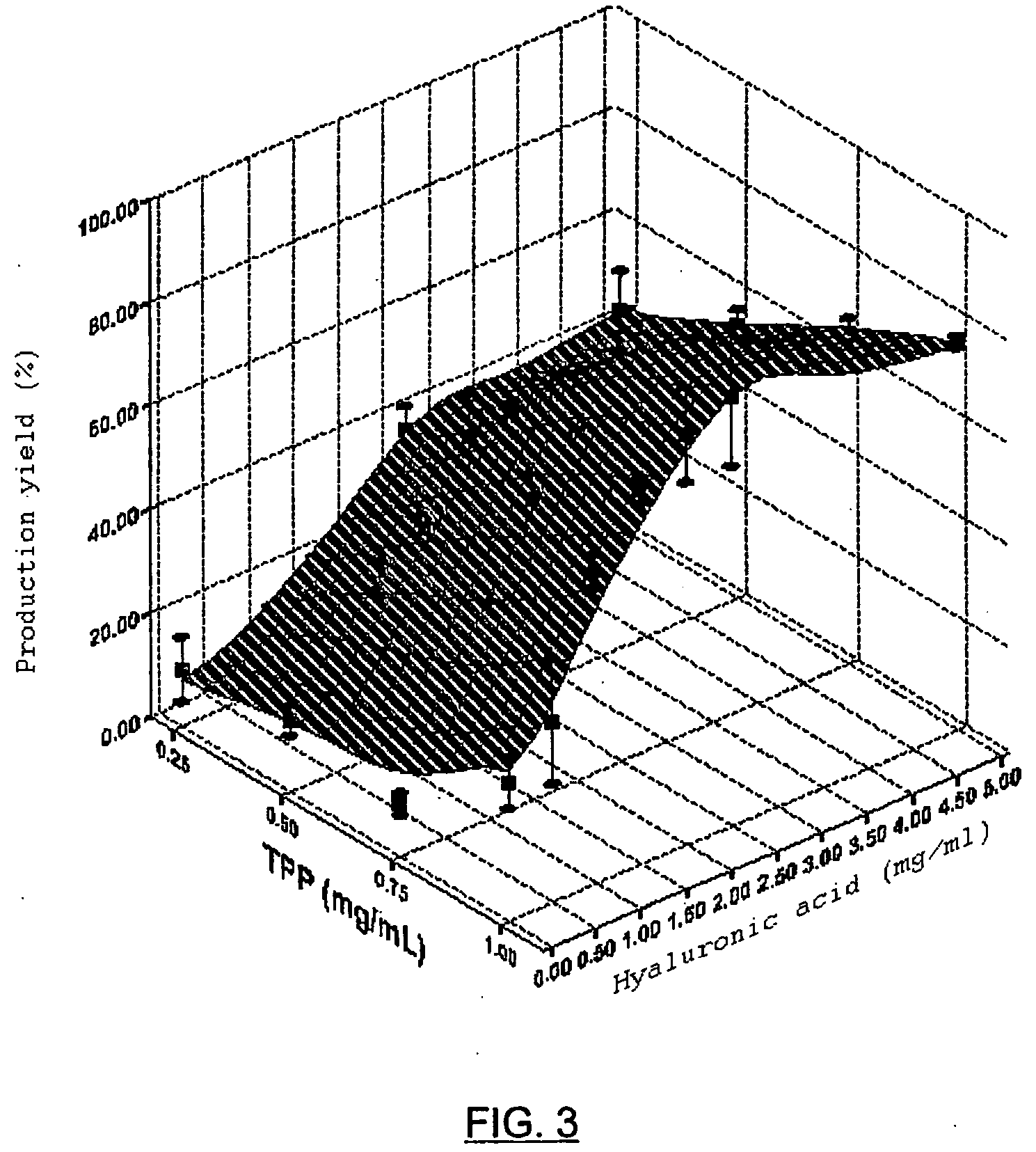Hyaluronic acid nanoparticles
a technology of hyaluronic acid and nanoparticles, which is applied in the direction of biocide, plant growth regulators, pharmaceutical non-active ingredients, etc., can solve the problems of limited access of hydrophilic macromolecules to the interior of the organism, numerous difficulties in administration of active ingredients, and prone to deformation, etc., to achieve greater control, greater stability, and high potential in the therapeutic field
- Summary
- Abstract
- Description
- Claims
- Application Information
AI Technical Summary
Benefits of technology
Problems solved by technology
Method used
Image
Examples
example 1
[0065] Hyaluronic acid nanoparticles in the form of sodium salt, chitosan as cationic polymer and sodium triphosphate as crosslinking agent, were prepared according to the previously described method. The hyaluronate and sodium triphosphate solution were added to the chitosan solution, with magnetic stirring, which is maintained for half an hour, permitting the complete evolution of the system towards a stable nanoparticulate form. Once prepared, their mean diameter is measured, as well as their surface electric charge (zeta potential) and the production yield is calculated (which is expressed in percentage and takes into account the weight of the nanoparticles with respect to the weight of the incorporated polymers). Table 1 and FIGS. 1, 2 and 3 show the values which are taken as said parameters in accordance with the proportion of HA-Na, Cs and TPP.
TABLE 1Mean diameter−PotentialProductionHA-Na / CS / TPP(nm)(+mV)yield1 / 1 / 0.05769 ± 36+36.09 ± 0.9943 ± 0.51 / 1 / 0.1696 ± 129+34.50 ± 0.28...
example 2
[0066] Hyaluronic acid nanoparticles in the form of sodium salt, chitosan as cationic polymer and sodium triphosphate as crosslinking agent, were prepared according to the previously described method. A hydrophilic molecule was then incorporated in its composition, selecting FITC-BSA for said purpose. It is a negatively-charged macromolecule in both solutions due to the pH thereof (3 in the case of the chitosan solution and between 8-8.5 in the case of the hyaluronate and tripolyphosphate solutions), for which reason it was incorporated together with the hyaluronic acid to avoid the appearance of interferences in particle formation.
[0067] A theoretical charge of 30% was established with respect to the polymer weight, and the encapsulation efficiency was determined (evaluating the free protein by visible spectroscopy, with =494nm) after being prepared according to the method of the invention. Its mean diameter was also measured. The production yield was determined taking into consid...
example 3
[0068] Hyaluronic acid nanoparticles in the form of sodium salt, chitosan as cationic polymer and sodium triphosphate as crosslinking agent, were prepared according to the previously described method. A hydrophobic molecule was then incorporated in its composition, taking for this the polypeptide cyclosporin A, an immunomodulator agent which is practically insoluble in water, especially at moderate temperatures. The preparation method is the one already disclosed in the present invention, with one modification, since the macromolecule is previously dissolved in a 50% (V / V) acetronitrile / water solution, with a concentration of 10 mg / mL. Then, a small volume of this solution, approximately 200 L is added to the chitosan solution, and immediately afterwards the solution which contains the hyaluronic acid salt and the crosslinking agent is added. The drug encapsulation has the form of nanocrystals, which justifies the addition process of the second solution being fast, avoiding the macr...
PUM
| Property | Measurement | Unit |
|---|---|---|
| concentration | aaaaa | aaaaa |
| concentration | aaaaa | aaaaa |
| concentration | aaaaa | aaaaa |
Abstract
Description
Claims
Application Information
 Login to View More
Login to View More - R&D
- Intellectual Property
- Life Sciences
- Materials
- Tech Scout
- Unparalleled Data Quality
- Higher Quality Content
- 60% Fewer Hallucinations
Browse by: Latest US Patents, China's latest patents, Technical Efficacy Thesaurus, Application Domain, Technology Topic, Popular Technical Reports.
© 2025 PatSnap. All rights reserved.Legal|Privacy policy|Modern Slavery Act Transparency Statement|Sitemap|About US| Contact US: help@patsnap.com



